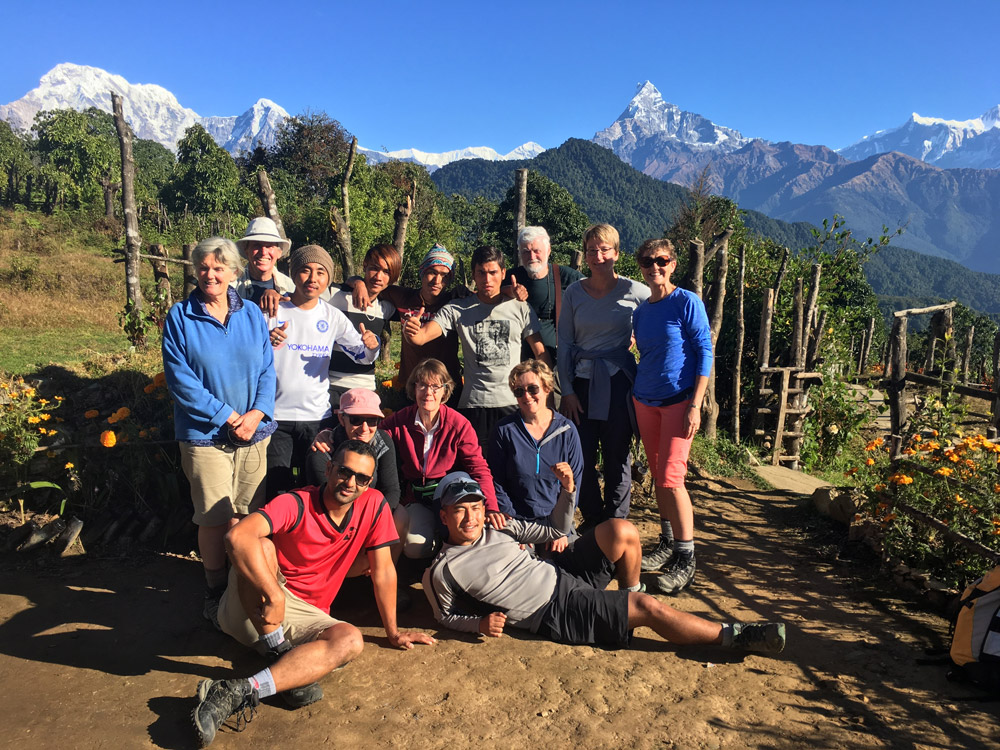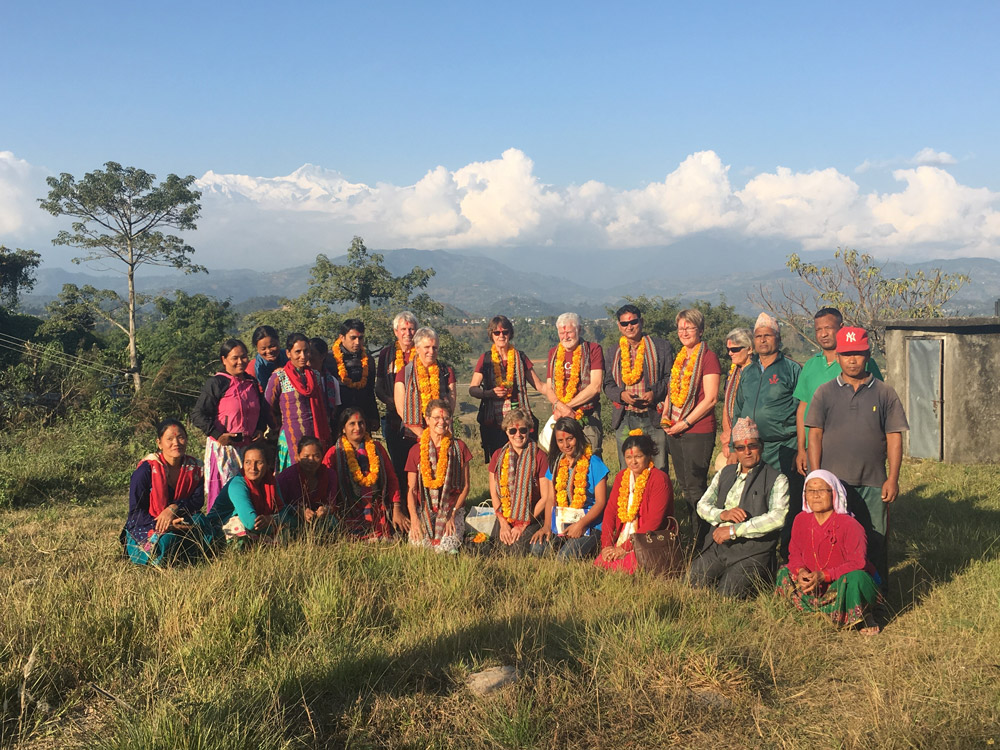Nepal calling for Jan and Gavan

Trekking team with porters and guuide (Jan kneeling centre; Gavan 3rd from right at rear)
Caritas is a “..non-political and not for profit organization… devoted to serving the poor; the most disadvantaged and the marginalised, irrespective of race, caste or creed , colour and religion.” (Caritas Nepal Growing Together in Solidarity).
BEFORE Jan and Gavan Cashman could participate a six day trek in the Annapurna region of Nepal, they had to raise $7000 between them for Caritas Australia.
Not only did the South Belconnen parishioners meet their target for Caritas, but they exceeded it.
“We have always been extremely impressed with its collaborative and empowering work in most needy communities,” Mrs Cashman said.
“The idea of supporting the work of Caritas and at the same time being part of an exciting adventure was very appealing to us.”
Many people from the couple’s former parish of St Matthew’s Page, wonderful families and friends, were most generous with their donations.
During the fundraising phase they were encouraged and supported by Viviane Piccinini of Caritas as well as by Jenny Keyes and her team at Inspired Adventures – the travel agency which organised the trip.
After months of training and fundraising, they landed in Kathmandu about midnight on November 10 last year.
The group joining Mr and Mrs Cashman comprised of Catherine McGrath and Scott Herring from NSW, Caritas representative Kerry Stone and her husband Colin, Jacinta Cosgriff from Victoria, Judy Mason from Tasmania; and Toni McGrath from South Australia.
On the first day…
On their first day in Kathmandu, the group attended a vibrant and colourful Mass in the Assumption Church.
“The singing was wonderful,” Mrs Cashman said.
“After the Mass we were given a presentation at the Caritas Nepal Office on the work of the organisation in Nepal, the humanitarian challenges it faces and the breadth of projects it undertakes to address these.”
They visited three world heritage sites: Boudhanath, the largest Buddhist stupa in the world, Pashupatinath, a Hindu cremation site on the banks of a river, and Durbar Square, Kathmandu’s “beating heart”.
“We saw signs of the devastating effects of the 2015 earthquake and restoration work being undertaken by various international agencies on buildings of high cultural significance,” Mrs Cashman said.
“Traffic in Kathmandu is chaotic!”
From Kathmandu they took a short flight to Pokhara, with stunning views of the Annapurna Range, in the foothills of which their six day trek was to take place.
After lunch they were welcomed at Caritas Kaski Office and given a presentation on the work of organisation in the Pokhara District.
They were then taken to see the Integrated Pest Management Program for Small Farmers.
It is aimed at providing education and support for farmers to reduce their reliance on pesticides and to make their farming practices more sustainable generally.

At the Integrated Pest Management Program for Small Farmers near Pokhara (Jan and Gavan standing in centre) Picture: Supplied.
The trek begins
On November 13 the group began the trek with a daunting 3,767 steps upwards.
For the next five days they traversed the foothills of the Annapurna Range, mostly steep up and down stages but occasionally pleasant strolls through forests of oak and rhododendron.
Magnificent views of the Annapurnas and beautiful terraced fields accompanied them. There were occasional rest stops at little villages.
Along the trails they exchanged many friendly ‘namastes’ with Nepalese travellers and other trekkers.
“The long days ended at teahouses where we enjoyed Nepalese food and drink and then retired to basic sleeping quarters,” Mrs Cashman said.
“Masala tea and Everest beer went down well but not together.
“In the mornings we were often rewarded with a spectacular view of the sun rising over the Annapurnas.”
Along the way they saw children spinning tops, villagers returning from the fields, older children carrying smaller siblings up the slate and stone steps and simple dwellings, sometimes with solar panelled rooftops along with colourful clothes drying in the sun on stone walls with pickles fermenting in jars.
The mountains are sacred to Hindu and Buddhist and Annapurna is the name of the goddess of the harvest.
“Machhapulchhare, the Fish Tail, one of the eight mountains in the Himalayas that is over 8,000 metres, is most shapely and beautiful,” Mrs Cashman said.
“It has never been climbed and climbing it is now forbidden.
“We are sobered by the realisation that the solar panels, metal water tanks, other building materials, beer and the contents of the tea houses and other supplies, have all been carried in for days at a time on the backs of people or mules.”
The work of Caritas
Mrs Cashman was full of praise for Caritas and the work that they are doing.
“This extraordinary trip has brought home to us the disparity between the privileged life for many of us here in Australia and how hard life is for most Nepalese people – and yet their lives are full of cheerfulness and dignity,” she said.
“We saw how Caritas is empowering the poor and marginalised to improve their lives and perhaps the glow of the sunrise over the Annapurnas is a kind of metaphor for the optimism which this empowerment is bringing about.”
The Cashman’s then flew back to Kathmandu and the following day travelled for two hours by Four Wheel Drive to the Caritas Nepal Kavre office.
Substantial background to The Earthquake Recovery Program is provided and they then go off on a rocky journey to see how a new concrete tank and pump house bring water to a village up on the hill. Former water springs were destroyed by the earthquake. Villagers are empowered by Caritas to rebuild their homes and their livelihoods through low interest loans.
“It is wonderful to see the pride taken in a new model house built for a lady considered most vulnerable,” Mrs Cashman said.
“Training in the raising of goats is also provided.”
As they walked up the steep dirt track they saw a young girl filling a huge cane basket with bricks, which she was to carry high up to the ridge for the family’s new house.
Yet again the Cashman’s are received with great hospitality, red dots on their foreheads (and sometimes noses!) and more marigold garlands. They celebrated with the villagers, the local Caritas staff and the co-operative manager, by drinking black tea from pretty china teacups.
On the return journey from Kavre they got caught up in a traffic jam for an hour and a half.
A local pedestrian had been hit and killed by a truck and amidst all of the upset the police arrive bearing batons and wearing full riot gear.
Their last day in Nepal was a final assault on Kathmandu with gift shopping and fruit buying from the bicycle fruit stalls. They took a breather in The Garden of Dreams. Set in the midst of Nepal’s capital and created in 1920 with exquisite pavilions and fountains.
It refreshes the weary trekker after the sightseeing and constant buzz of the city.


